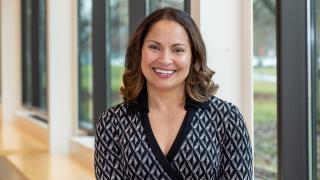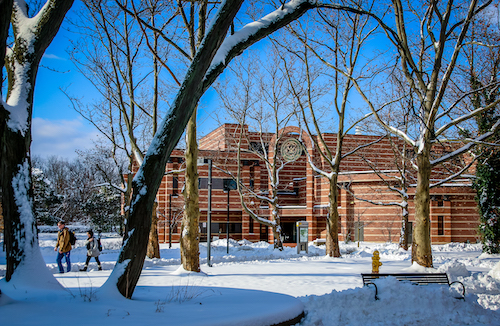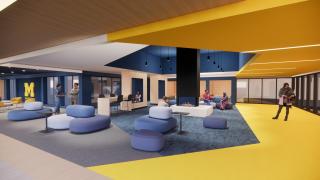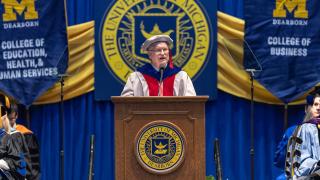
As you know, the UM-Dearborn community is currently engaged in a strategic planning process to build a vision for the university’s next decade and beyond. Thus far, much of the heavy lifting has fallen to five working groups, made up of faculty, staff and students. Collectively, those groups have spent hundreds of hours compiling compelling ideas, big and small, that could improve everything from how we use physical spaces on campus to faculty research to student success. At three town halls later this month, the larger campus community will have an opportunity to provide feedback about each working group’s report — and offer up their own ideas. So in case you haven’t had a chance to dig into the full reports, we’ve pulled out several big themes from each group. We’ll cover three working groups in this post, and two in a post later this week. If you get interested in a particular topic, you can find summaries and full working group reports. Enjoy!
Resources, Structure, Efficiency and Management (RSEM)
Shorter semesters, fewer classes. Is it time to rethink two of the most durable conventions in higher ed: the 14-week semester and the 3-credit class? The RSEM working group says a 7-week term structure has some big benefits — chief among them, the ability of students to focus on just 2 or 3 courses at a time. The system might also have advantages for faculty, especially if the 7-week term was accompanied by a switch to 4-credit classes. Under this system, faculty would have just a single class to prep for each 7-week semester, leaving more concentrated time for research. In both cases, the core concept is that we perform better when our attention isn’t pulled in too many directions.
Establish a ‘College of Urban Futures.’ One of the biggest ideas in the strategic plan is a new university enterprise called Urban Futures. This highly interdisciplinary approach emphasizes practical solutions to contemporary urban issues like mobility, sprawl, housing affordability, pollution, environmental justice, as well as new challenges from climate change and emerging technologies. As such, it leverages the talents of faculty and students from all disciplines and engages our local communities in ways that are highly relevant to their lives. In the form of a brand new college, could this be something that makes UM-Dearborn stand out?
Going Carbon Neutral. In response to climate change, the University of Michigan system has made a commitment to going completely carbon neutral. That means, we’ll need to develop a comprehensive plan for our campus, which will include, among other things, new investments in energy efficiency and doing something pretty big about our commuter culture.
A Go Blue Guarantee and Job Guarantee at UM-Dearborn. Could offering tuition-free enrollment for students with household incomes under a certain level be part of our future? There’s no doubt programs like this are gaining steam: UM-Ann Arbor has the “Go Blue Guarantee” and Wayne State University recently announced its similar “Heart of Detroit” program for eligible students. In this environment, having a tuition-free option of our own could help us stay competitive and increase access to way more students. The major issue, of course, is cost. The RSEM working group estimated a Go Dearborn Guarantee would cost $10-$17 million per year. As for who pays for it, the group outlined two possible options. UM-Dearborn could find a way to cover the cost itself; or the University of Michigan system could adopt Ann Arbor’s current “Go Blue Guarantee” as a three-campus initiative, with financial support coming from annual returns on an estimated $250-$430 million endowment. The RSEM working group also explored another “guarantee” as a potential enrollment booster: A job guarantee for any undergraduate who earns a degree. Notably the proposed MPact program wouldn’t exactly guarantee students a job. Instead, eligible undergraduates would be extended an offer for 50 percent discounted graduate tuition if they weren’t able to find employment within six months of graduation.
Public Prominence, Awareness, Partnerships and Community Engagement (PPAPCE)
Building the recruitment pipeline. The need to expand enrollment beyond the shrinking pool of graduating high school seniors could fundamentally shift the way universities recruit students. One idea from the PPAPCE working group: Start developing relationships with prospective students at a much earlier age. This could take the form of 5-day summer camps, where middle schools students would get to visit campus for experiences relating to their interests (e.g. sports or robotics); placing mentors or UM-Dearborn-sponsored “maker spaces” in local schools; or partnering with community spaces like the Henry Ford Museum.
Building a more diverse student body. The situational analysis informing the strategic planning process identified African American students and Latinx students, particularly in Detroit, as two emerging demographics that could fuel future enrollment. But what’s the best way to engage students from these historically underrepresented groups — and more importantly, set them up for success once they’re on campus? The PPAPCE working group suggested the Meyerhoff program as a possible model. Founded at the University of Maryland, Baltimore County in 1998, this scholarship program has earned national attention for boosting college success among African American students, especially in STEM fields. Other universities are starting to replicate it.
Deconstructing the ivory tower. One of the things that’s thought to be eroding the public’s opinions of higher ed institutions is their relative isolation from the communities they serve. Here’s the basic problem: If most people don’t visit a college campus, and most of the amazing research and cultural programming we do happens on campus, then they’ll never have a direct experience of our value. The antidote: Break down the barriers that separate us from our community. A couple strategies for doing this include hosting more events in the community, especially featuring university experts whose work emphasizes direct, local community benefits; training experts to present their work in digestible, non-technical ways; and working with local community partners to develop free online classes or short-courses that are particularly relevant to local residents.
Student Engagement and Success (SES)
Creating a residential honors college. UM-Dearborn currently has two honors programs (one in CASL and the new “experiential” honors program in CECS). But could we dream bigger and establish a universitywide, residential honors college? The goal of this would be to create a tailored experience for high-achieving students that combines curriculum, experiential learning and a cohort experience. The Honors College could be hosted at the Union or a new residential space.
Create a First-Year Experience for students. In an era where the pipeline of traditional college students is narrowing, retention is becoming all the more important to maintaining healthy levels of enrollment. A smooth initial transition to college plays a significant role in retention for traditional, transfer and first-generation students, and the SES working group recommended establishing a First-Year Experience program to support early student success. Mandatory for all FTIAC (first-time-in-any-college) and transfer students, the First-Year Experience would incorporate advising, on-campus and off-campus group activities, and shared experiences like a Common Read.
Using technology to solve common student problems. Whether it’s academic advising or getting help with financial aid, students constantly need help navigating the university bureaucracy. But could technology help streamline the process of answering their most common questions? Ideas for this include building a mobile app for basic university services; a text-messaging system to remind students of important dates; an AI-based chat tool to answer common questions; and developing a “financial health checkup” tool for students to assess their pathways to graduation. To compliment these efforts, the SES working group recommended the creation of a Student Advocacy Center, which would use a case management model to connect students to resources when they need them.






